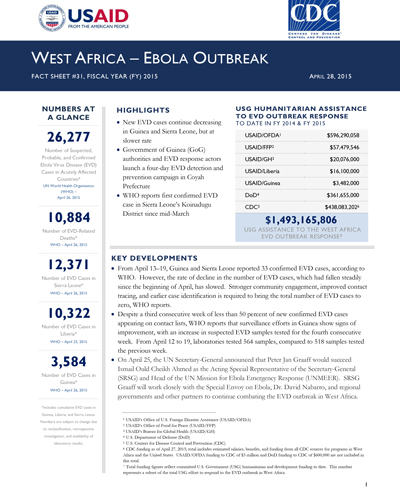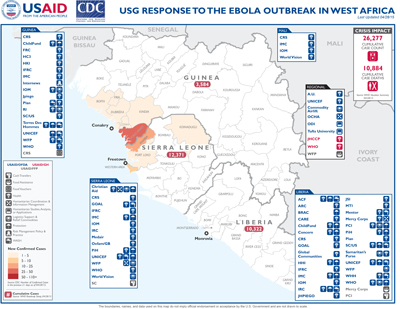Speeches Shim
April 28, 2015
HIGHLIGHTS
Ebola Response
Visit our main West Africa Ebola Outbreak page to learn more about how we're responding to the West Africa Ebola outbreak, and what you can do to help.
- New EVD cases continue decreasing in Guinea and Sierra Leone, but at slower rate
- Government of Guinea (GoG) authorities and EVD response actors launch a four-day EVD detection and prevention campaign in Coyah Prefecture
- WHO reports first confirmed EVD case in Sierra Leone’s Koinadugu District since mid-March
West Africa Ebola Outbreak Fact Sheet #31 (FY 15) ![]() (pdf - 306k)
(pdf - 306k)
KEY DEVELOPMENTS
- From April 13–19, Guinea and Sierra Leone reported 33 confirmed EVD cases, according to WHO. However, the rate of decline in the number of EVD cases, which had fallen steadily since the beginning of April, has slowed. Stronger community engagement, improved contact tracing, and earlier case identification is required to bring the total number of EVD cases to zero, WHO reports.
- Despite a third consecutive week of less than 50 percent of new confirmed EVD cases appearing on contact lists, WHO reports that surveillance efforts in Guinea show signs of improvement, with an increase in suspected EVD samples tested for the fourth consecutive week. From April 12 to 19, laboratories tested 564 samples, compared to 518 samples tested the previous week.
- On April 25, the UN Secretary-General announced that Peter Jan Graaff would succeed Ismail Ould Cheikh Ahmed as the Acting Special Representative of the Secretary-General (SRSG) and Head of the UN Mission for Ebola Emergency Response (UNMEER). SRSG Graaff will work closely with the Special Envoy on Ebola, Dr. David Nabarro, and regional governments and other partners to continue combating the EVD outbreak in West Africa.
West Africa Ebola Map #31 April 28, 2015 ![]() (pdf - 517k)
(pdf - 517k)
Liberia
As of April 22, representatives from the Government of Liberia (GoL) Ministry of Health (MoH) and WHO, accompanied by USG Disaster Assistance Response Team (DART) staff, had visited eight Liberian counties—Gbarpolu, Grand Bassa, Grand Gedeh, Grand Kru, Lofa, Maryland, River Gee, and River Cess—to discuss the GoL-led EVD treatment unit (ETU) transition plan. Each county visited has a closed ETU or an ETU scheduled to close in the coming month. During the visits, MoH and WHO representatives explained the ETU decommissioning process and timeline, and sought to identify gaps in county-level capacity to safely isolate, triage, test, and refer suspected EVD patients in the absence of an ETU. The MoH and WHO plan to conduct visits to the remaining six counties beyond Montserrado County—Bomi, Bong, Grand Cape Mount, Margibi, Nimba, and Sinoe—in the coming weeks.
EVD specimen transport remains a challenge in many parts of Liberia and a growing concern as the May–October rainy season approaches. To help address transport needs, the CDC Foundation has supported the non-governmental organization (NGO) Riders for Health to establish a specimen transport network in Liberia. To date, Riders for Health reports training couriers in Montserrado and is working with county health teams to identify and train couriers in seven counties in southern Liberia by the end of May, followed by training couriers in the northern counties by the end of June.
With nearly $7.8 million in USAID/OFDA support, Samaritan’s Purse is implementing EVD response programs, including EVD awareness messaging for more than 284,000 people and distributing more than 47,000 infection prevention and control (IPC) kits in Gbarpolu, Grand Kru, Lofa, Margibi, Montserrado, and River Gee. Samaritan’s Purse also established and is managing community care centers and providing training to build county-level capacity to implement the GoL Rapid Isolation and Treatment of Ebola strategy. On April 23, DART staff traveled to Lofa to meet with Samaritan’s Purse and visit two EVD-affected communities in Kolahun District where Samaritan’s Purse is responding. Both communities have received household IPC kits, including buckets, chlorine, and soap, as well as EVD education. DART staff observed that the majority of houses in the communities had hand washing facilities, and community members were able to identify EVD symptoms, list best behavioral practices to avoid EVD, and explain the process for reporting and referring a suspected EVD case.
Sierra Leone
On April 22, WHO reported that Serra Leone’s Western Area Urban District—which includes the capital Freetown—confirmed six EVD cases, or half of the country’s 12 cases, in the week of April 13–19. Koinadugu District, which borders Guinea to the north, and Port Loko District each reported one new confirmed case, and Kambia District reported four confirmed cases. The case in Koinadugu is the first confirmed EVD case since mid-March, according to WHO. The National Ebola Response Center (NERC) reports that the new case remains under investigation, with the source of transmission unknown. The Koinadugu District Ebola Response Center had quarantined a number of the confirmed case’s contacts and continues contact tracing and surveillance efforts.
In early April, the International Medical Corps (IMC) assumed management of the USAID/OFDA-supported holding center in Kambia. In coordination with the Kambia District Ebola Response Center, IMC scaled up the facility’s capacity to treat patients and reopened the site as an ETU on April 13. On April 22, the NERC formally approved the establishment of the Kambia ETU, noting ongoing transmission in the district and highlighting that an ETU within the Kambia community is likely to improve community engagement and cooperation with ongoing EVD response efforts.
In coordination with the Government of Sierra Leone (GoSL), NGO partners, and other stakeholders, CDC continues to support EVD screening at all points of entry and exit throughout Sierra Leone. At Freetown’s Lungi International Airport, CDC is supporting the International Organization for Migration (IOM) to monitor screening. As of April 10, the program had assessed more than 25,400 travelers, including people arriving to Freetown and departing for other locations, since September. CDC also provided technical assistance to response actors developing maritime standard operating procedures, which includes screening procedures for individuals traveling through Sierra Leone’s seaport.
USAID/OFDA is supporting the International Rescue Committee (IRC) with $5.3 million to strengthen IPC capacity in Sierra Leone’s hospitals. In Kono’s Koidu Government Hospital, an IRC IPC mentor is training approximately 300 hospital staff based on the IPC curriculum developed by CDC and the GoSL Ministry of Health and Sanitation. After the staff receive training, IRC plans to shift activities to on-the-job training and IPC supervision. Separately at Koidu, the USAID/OFDA-supported organization Partners in Health (PiH) is supporting triage and screening at the hospital entrance.
Guinea
From April 12 to 19, the GoG and WHO reported 21 new confirmed EVD cases—a 25 percent decrease from the 28 cases reported the previous week. With 18 cases, Forécariah Prefecture accounted for 86 percent of all new cases. The capital city of Conakry reported one new confirmed case, compared to six confirmed cases documented the prior week. Coyah and Fria prefectures also reported one new confirmed case each.
On April 24, prefectural-level GoG authorities and EVD response actors launched a four-day EVD detection and prevention campaign in Coyah. Preliminary reports indicate that approximately 600 teams visited more than 42,400 households. EVD response actors received 23 community death alerts, although none tested positive for EVD. On April 27, the Coyah prefectural-level emergency operations center reported that 43 households refused to speak with the sensitization teams. Despite some minor setbacks, the National Ebola Coordination Cell confirmed effective implementation of the campaign.
A Guinean court has sentenced 11 people to life in prison for killing members of an EVD response team that was raising awareness of EVD risks in September 2014. The attack, which occurred in Womey, Nzérékoré Prefecture, led to the deaths of eight persons, including two doctors and three journalists, according to an UNMEER report.
In response to an uptick in community reticence against EVD response actors in Boffa, Boké, and Lola prefectures, WHO Guinea released safety and security guidelines for EVD response actors. The guidelines state that response actors should obtain agreement from local authorities before visiting prefectures, request security elements when travelling in reticent areas, meet the village chief before starting operations, maintain vigilance of personal surroundings at all times, and report security incidents to local authorities, among other directives. The safety protocols come after community members in Boffa attacked Guinean Red Cross staff on April 21, seriously injuring two Guinean Red Cross staff and two local officials, in addition to damaging the only operable ambulance in the prefecture.
PUBLIC DONATION INFORMATION
- The most effective way people can assist relief efforts is by making cash contributions to humanitarian organizations that are conducting relief operations. A list of humanitarian organizations that are accepting cash donations for disaster responses around the world can be found at www.interaction.org (link is external).
- USAID encourages cash donations because they allow aid professionals to procure the exact items needed (often in the affected region); reduce the burden on scarce resources (such as transportation routes, staff time, and warehouse space); can be transferred very quickly and without transportation costs; support the economy of the disaster-stricken region; and ensure culturally, dietary, and environmentally appropriate assistance.
More information can be found at:
- The Center for International Disaster Information: www.cidi.org (link is external) or +1.202.821.1999.
- Information on relief activities of the humanitarian community can be found at www.reliefweb.int (link is external).
USAID/OFDA bulletins appear on the USAID website at what-we-



Comment
Make a general inquiry or suggest an improvement.